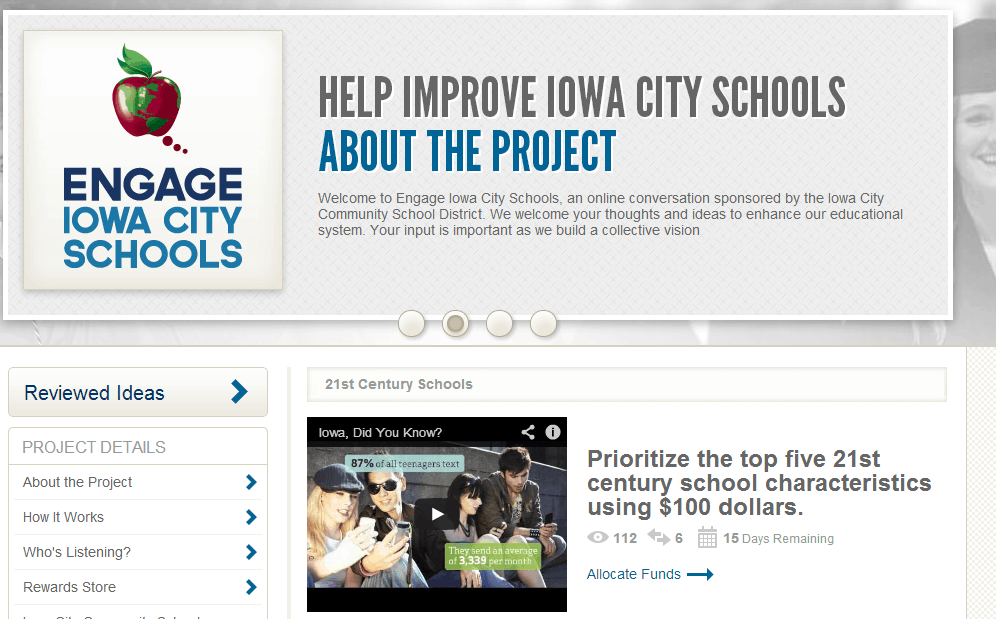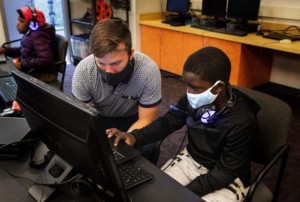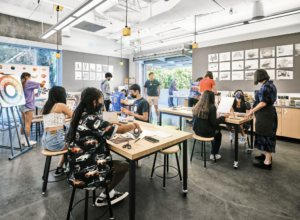MindMixer: It Takes a Community

The Internet has made the world smaller and our minds larger. As the barrier of geography shrinks, the sharing of ideas increase. Education is starting to reap the benefits of the crowd like the private sector has being doing for some time. Web tools like Twitter and Facebook have helped schools communicate with their surrounding communities. As a school, though, wouldn’t it be great to connect with your community in a systematic way that cultivates ideas and keeps the community engaged?
Meet MindMixer.
Mindmixer, based in Omaha, functions like a virtual town hall. In the early stages of the service, Mindmixer focused on municipalities and civic organizations, but now they have found a great fit with education. MindMixer is a lot like KickStarter, but KickStarter crowdsources for funding. Mindmixer crowdsources for ideas. When budgets shrink, new ideas become paramount. Check out this short MindMixer video:
I had the opportunity to speak with Nick Bowden, the cofounder of MindMixer. Here’s some of our discussion:
Adam: How did MindMixer come about?
Nick: Nathan Preheim and I started the company 2 years ago. We were both urban planning consultants. We were working on urban design projects in cities across the country and in part of the process we were doing a ton of town hall meetings. The interesting thing about that work is we felt like it was really important work as it was changing the physical layout of the cities that we were working in. The discouraging part, though, was these town hall meetings, regardless of the size of the city, tended to attract at most 50 people, but more usually 10 to 15 people. We felt that a lot of these cities were making really important decisions based on a small sample size of participants. That led to us to the question, is there a way that we can build a platform that has the nuisance of engagement built into it but would allow for cities to more broadly engage their citizens in important civic topics and decisions within the realm of community? That was our founding principle.
Adam: I’ve seen similar things in webinars I’ve hosted or attended. We might only have 15 or 20 people attend a live virtual meeting, but 600 people may listen to the archive and leave comments. Why do you think there was such low turnout at the civic meetings?
Nick: It was interesting for us that a lot of cities tended to think that there was citizen apathy around these projects, but we felt like that wasn’t the case. It was an issue of convenience. So fast forward 2 years, and we now work with over 400 organizations in the U.S. and Canada.
Adam: And how did you get in the education space?
Nick: It was about a year ago that community leaders started telling us that we should really talk to the local school districts as they faced a lot of the same challenges that the local governments and civic organizations did. The usual voices always attended the school board meetings and they weren’t getting the really high level of parental engagement that they wanted. So that was our start in the education world. Now we work over 50 schools, districts, and universities. It’s been fascinating for us to watch. It was clear to see that people care more about their children than in civic projects in the city where they lived.
Adam: How has the school response been to MindMixer?
Nick: The popularity of MindMixer forums in school districts has been just overwhelmingly positive. Ultimately, schools are now making more informed decisions because they have a broader set of voices involved and also because they have a set of data around the demographics and locations of participants. This has given them insight to where the participants live in the district or how many kids they have in school. Those demographics impact the kinds of things that end users, parents and the surrounding community, are interested in and the priorities that they have.
For whatever reason both civic and educational organizations have tended to focus their engagement efforts on specific events or in an episodic fashion around a particular project, and the challenge with that is that they would have a heightened level of interest around that project but then they wouldn’t reach back into the community for three, four, five, or even twelve months until the next project came out. So these organizations were spending an enormous amount of time and resources to attract parties to a particular event. Then once the event was over, all those people were gone, and then the next event would come up, and they would have to reacquire an audience again.
Adam: And then the right technology arrived.
Nick: Yes, before they didn’t have tools to have a perpetual conversation with issues that were maybe not super important, but interesting enough keep people engaged over time and to build a group of people who you continually tap back into when you needed feedback on an important issue. Obviously technology allows us to do that now. You don’t have to go get 100 people to show up to a meeting, and then they disperse and you can’t reach back into them. We try to educate organizations on the importance of establishing a relationship and keeping that relationship over time. There are a lot of direct benefits with both time and resources in not having to acquire an audience every single time you do an engagement effort.
Adam: This really shrinks geography and suspends time. Where you the visionary on this? How did the technology get built?
Nick: This is my second business I’ve started. I had a consulting practice in urban planning before MindMixer. Initially Nathan and I worked together at a large engineering firm. He spent six years in the Bay Area during the dot com boom, so his background was half tech and half urban planning. My background was half urban planning and half business, so we are a perfect compliment in the sense that he’s handled the technical pragmatic “how do we make something work” and that allows me to think about how do we make it better than before in an exponential fashion. The neat thing about this is we have very different perspectives on how to achieve a shared vision or outcome.
Adam: Was there an “aha moment” where you realized you had to take on this endeavor together?
Nick: Yes, the breaking point for us happened when we were driving seven hours back from a public meeting in rural Kansas. We were on the fourth meeting in four days we had four people show up, and I said to Nathan that we can’t do this anymore.
Adam: Now that you’re over two years in, what would you say the best features of MindMixer are?
Nick: We have two clients. We have the formal clients who we partner with. That might be a civic organization or a school district, and their experience is quite different than the end user who might be the student or the parent or the faculty member. On the end-user side, the richness and diversity of the types of feedback that you can give is unique. We have topic types that are both very open ended where we are asking for your ideas for the future of the school district and then also topic types that are transactional and are more close ended, which would be the ability to take a survey on something like your opinion of the school calendar. Mixed in with that, we have social features where you can share things like photos of your favorite school events and an interactive budget tool where you can play superintendent for a day and think about how you might allocate the budget based on the constraints that the district might have.
Adam: An interactive budget tool? I’ve not seen that before. Not in a forum type setting. That is unique. How about on the district end?
Nick: From the organization side, we do not allow for anonymous participation on our sites, so end users have to sign up by providing just a little bit of information about themselves, like their age and location. That allows us to provide a glimpse into how geography and age impact people’s priorities, which districts can consume from their MindMixer dashboard. So rather than just seeing that 500 people want a school calendar, they can see that 400 of those 500 are 35-45 year-old parents who live in the south side of the district.
Adam: Can you talk about the rewards feature?
Nick: As much as we hope that people will participate for utopian reasons, there are some things we can do to make it fun. We do use a point system that rewards really good ideas vs. other social tools that reward the volume of content. If you put a good idea out there that receives a lot of support from other parents, you’ll earn a lot more points than if you put up a lot of ideas that don’t earn a lot of support. If districts choose to, they can integrate a rewards store where they can identify a couple of different rewards that tend to be access-based where members from the community get to have lunch with the superintendent or see a new facility that’s being built or a behind-the-scenes look at a school board meeting.
Adam: Do schools or school districts use MindMixer more?
Nick: To date it’s mostly been districts, but recently we’ve received a lot of interest from charter schools, which tend to be more autonomous at the school level, so we are seeing a movement to the individual schools. A lot of our contracts with the districts allow them to create microsites at their schools. Mindmixer is suited for both districts and individual schools. Its use is really determined by the amount of content you have to keep a conversation going, and much of that is driven by size and staffing. Larger schools can do that. For small schools, it would be more appropriate at the district level.
Adam: What can you tell us about your pricing structure?
Nick: Pricing goes from $299 to $899 per month, but that higher end is really reserved for the top 50 to 75 school districts in the nation. Most districts operate in the $299 to $599 range. The individual school level is anywhere from $49 to $149 a month.
———————————————————————
That concluded our conversation. It was refreshing to talk to a service provider in the ed tech space who had transparent pricing. That probably stems from Nick’s business background. It would be great to see those that have a mystery pricing structure follow MindMixer’s lead.
Districts can obviously use MindMixer to connect with parents and the community to solicit ideas and opinions. Check out Iowa City Schools’ and Boulder Valley School District’s MindMixer sites for an idea on how schools are using MindMixer.
Here are two MindMixer uses that I would use right away:
1) Connect with local experts in the community. Seek out the entrepreneurs and innovators who are probably eager to share their knowledge with students. Give these private industry leaders a way to connect with schools.
2) Connect with the community to identify local grand challenges. Wrap curriculum around those local challenges. For example, term papers and senior projects would focus on those challenges (homelessness, traffic congestion, juvenile crime, clean water, etc.). Math courses would use statistics from those local challenges to generate real-world questions. Multimedia classes would document those challenges in the community and promote awareness. Student government classes would coordinate school efforts with civic leaders. And so on and so forth. The community would be available to help students with their projects. In the end, students would study a challenge at school like clean water. They would also hear about it on their local news. They would see it first hand on the way home or at home. This would make learning and school much more relevant to students.
Right now you can create a free account on MindMixer. If you have an expertise, you can visit any of the MindMixer websites across the country and share your expertise when schools are districts are seeking it.








0 Comments
Leave a Comment
Your email address will not be published. All fields are required.